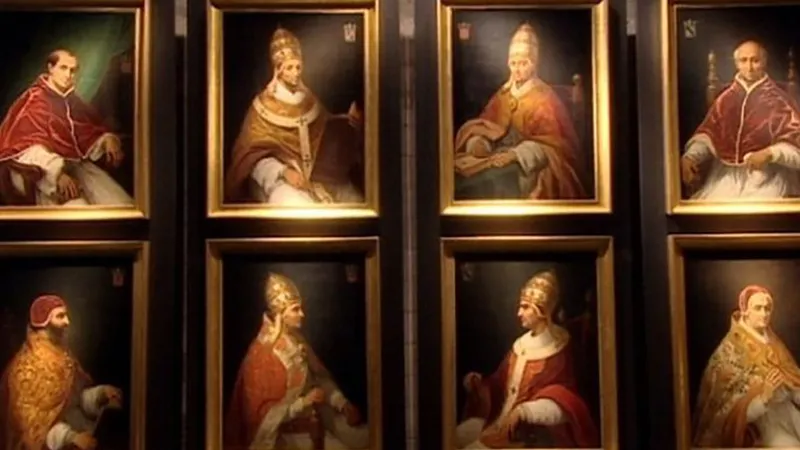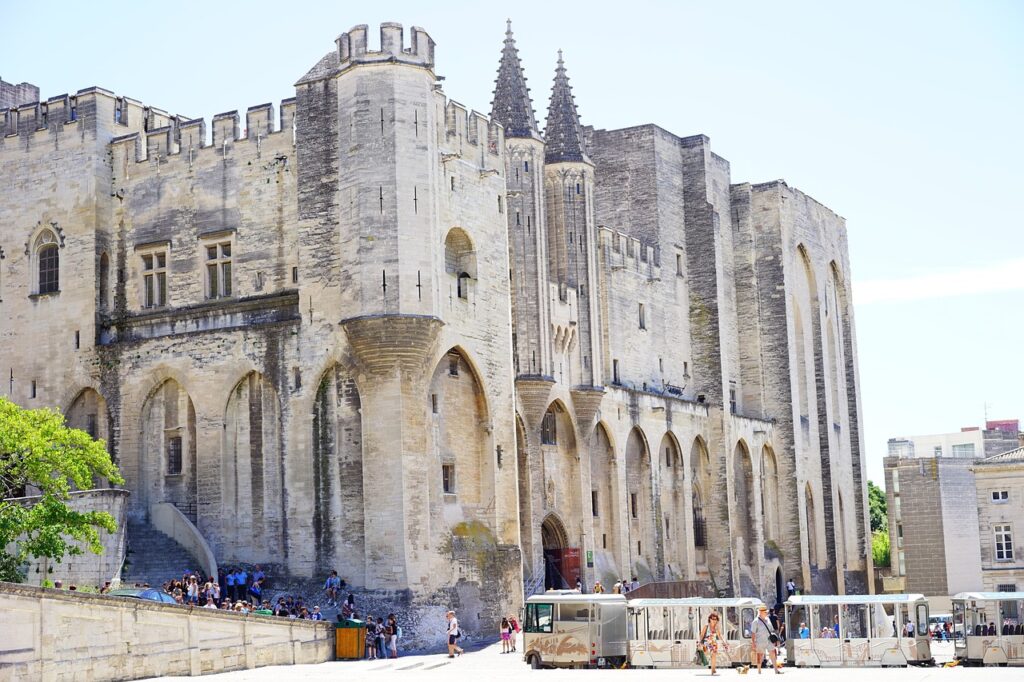
Avignon is a French city in the Provence-Alpes-Côte d’Azur region of Southeastern France. Located on the left bank of the river Rhône, it has a population of around 90,000 people. This small city possesses a unique feature that allows visitors to experience being in the medieval era.
With many medieval landmarks like the palace, city wall, churches, and other medieval structures, the city itself became a UNESCO World Heritage Site in 1995. Modern-day Avignon also features Provençal markets and great quantities of mouth-watering restaurants like haute French dining and neighborhood bistro. With direct trains from Paris, many visitors can easily visit the city and travel over the rest of the Provence.
However, today’s article will focus on the 14th century when it became the center of a catholic church for less than a century. Despite a short-lived time being the center of Christianity, the medieval era has a significant impact on the present-day of the city.
What is the Avignon Papacy and why did it occur?

Avignon Papacy refers to the term from 1309 to 1377, when 7 popes moved their residence from Rome to the city of Avignon. The Avignon papacy originated from a conflict between King Phillip IV of France and Pope Boniface VIII. In 1301, King Phillip IV arrested the bishop of Pamiers, resulting in Pope Boniface VIII retracting all privileges given to the French king.
After the death of Pope Boniface VIII, King Phillip IV used his influence to select Clement V as the new pope. However, this outcome was considered by the public in Rome to be unpopular, leading to Pope Clement V’s decision to move the papal capital to Avignon.
The French heavily influenced the Catholic Church, especially with Pope Clement’s decision to choose 111 out of 134 cardinals originated from France. Although the Papacy maintained its independence, the French monarchy occasionally exerted a strong influence. Throughout the history, there were 6 Avignonese popes recorded from 1309-1377:
- Clement V (1305-1314)
- John XXII (1316-1334)
- Benedict XII (1334-1342)
- Clement VI (1342-1352)
- Innocent VI (1352-1362)
- Urban V (1362-1370)
- Gregory XI (1370-1378)
Achievement of the Avignon Papacy
Despite gaining a bad reputation, the Avignon Papacy was not idle during this period (Muhaj, 2017). They made some efforts to improve the situation of Christianity and peace between the Christian kingdoms. Here are some achievements made by the Papacy:
- Administration Reformation: Extensive reorganization and centralization of Papal’s administrative offices and other agencies. Especially during the reign of Pope John XXII (1316-1334), when he saved the Catholic church from bankruptcy by creating a large reserve in the treasury. He also introduced a proper method to record all incomes for the Papacy, By doing this, it helps the Catholic church to prevent corruption and increase efficiency in administrative works.
- Expansion of Missionary: During the reign of Pope John XXII, he introduced reformations for the clergy and expanded missionary enterprises. In the later years of Pope Benedict XII (1334-1342), he successfully sent missionaries to China.
- Great emphasis on education was promoted during this era. The popes established many boarding schools in the Southern part of France. Furthermore, the Papacy distributed many benefits to support university students across Bologna, Montpellier, Paris, Perugia, and Toulouse.
- Peace Mediation: During the reign of Pope Benedict XII, the Papacy was very active in meditating peace efforts between France and England. In addition, the Pope successfully mediated a conflict between the Castillian Spanish and Portugal. Peace between the Spanish and Portugal played an important role in the victory against the Moors at the Battle of Rio Salado.
The End of Avignon Papacy
According to ThoughtCo, St. Catherine of Siena and St. Bridget of Sweden played an important role in persuading Pope Gregory XI to return to Rome. Finally, Pope Gregory XI decided to return to Rome on 17th January 1377. However, the pope’s stay in Rome attracted further hostilities and riots amongst the people. Before Pope Gregory XI returned to Avignon, he died in March 1378. His death signifies the end of the Avignon Papacy.
How does the Avignon Papacy influence modern-day Avignon?

67 years of the Avignon papacy radically transformed the city and left a significant mark on the city. Many constructions and renovations occurred during this period. The city is one of the few French cities that preserved its fortified city walls. Many people called the city as ‘La Cité des Papes‘ (The City-State of Popes).
Some constructions conducted during the Avignon papacy became UNESCO World Heritage Site in 1995. Palais de Papes, the Avignon Cathedral, and Musee Du Petit Palais were considered important sites in the 14th and 15th centuries. All these landmarks played a vital role in shaping the city as a major tourist attraction that attracts domestic and international tourists.
Palais De Papes (Palace of the Popes)


The construction of Palais de Papes started during the reign of Pope John XXII. He initiated the construction of an episcopal residence that connected with a cathedral, which later transformed into a pontifical residence. The construction of this largest Gothic palace took nearly 20 years to complete.
The palace was a combination of two palaces built by two popes, Pope Benedict XII built the old palace (Palaies Vieux) and his successor Clement VI built the new palace (Palais Neuf). By the time of completion, it occupied an area of 11,000m2. Due to its massive size, the palace was used for both church activities and administrative tasks.
The pope left Avignon in 1377 and returned to Rome, making the city vacant. In the next few years, anti-papal forces under Geoffrey Boucicaut conquered and captured the city. Only in 1433, papal legates regained the city under their control. Despite gaining back control of the city, the palace gradually deteriorated in the next hundred years.
When the French Revolution broke out in 1789, the revolutionary forces captured and sacked the palace. It became a massacre site for those fighting against the revolutionary forces. After the end of the French Revolution, Napoleon took control of the palace and changed its function to a military barracks and a prison. Only in 1906, the French government changed the function of the palace into a national museum.
Musee Du Petit Palais

Constructed in the 14th century as the residence of the bishops of Avignon. However, the function of this building changed into a museum and art gallery. It houses an exceptional collection of early Renaissance paintings from Italy. Due to its history, the palace became a UNESCO World Heritage Site along with the Pope’s Palace in 1995.
Cardinal Berengat Fredor the Elder initiated the construction of the Petit Palais around 1318-1320. After the end of the Avignon papacy, the building suffered badly during its use in 1396 as a fortified citadel and was wrecked by the time of the war in 1411. Only in the middle of the 15th century, the building receive a restoration work where some Renaissance features added to the building.
During the French Revolution, the government sold this building and it became a catholic secondary school in 1826. Another massive restoration work occurred late in 1961, where Jean Sonnier supervised the restoration of Petit Palais. In 1976, the commemoration of the building started and it became a national museum.
Avignon Cathedral

Another Avignon landmark is the Avignon Cathedral which located next to Palais des Papes. Today, the cathedral became the seat of the Archbishop of Avignon. The cathedral is a Romanesque building that began its construction in the 12th century.
The building had the same fate as other landmarks during the French Revolution, it was abandoned during the revolution in a very bad state. Only in 1822, archbishop Celestin Dupont initiated a massive restoration of the cathedral. The statue of the Virgin Mary on the top of the bell tower became a significant feature of the restored cathedral.
Also in 1995, the cathedral received recognition from UNESCO as a World Heritage Site along with Palais des Papes and Musee Du Petit Palais. The cathedral holds significance as an outstanding architecture in the medieval ages.
References:
https://www.thoughtco.com/the-avignon-papacy-1789454
https://www.avignon-et-provence.com/en/celebrities-provence/popes-avignon
https://worcestercathedrallibrary.wordpress.com/2021/10/10/the-avignon-papacy-and-the-great-schism/
Curta, Florin, and Andrew Holt. Great Events in Religion. Edited by Ardian Muhaj, vol. 2, Santa Barbara, ABC-CLIO, LLC, 1 Jan. 2017, pp. 631–632.
